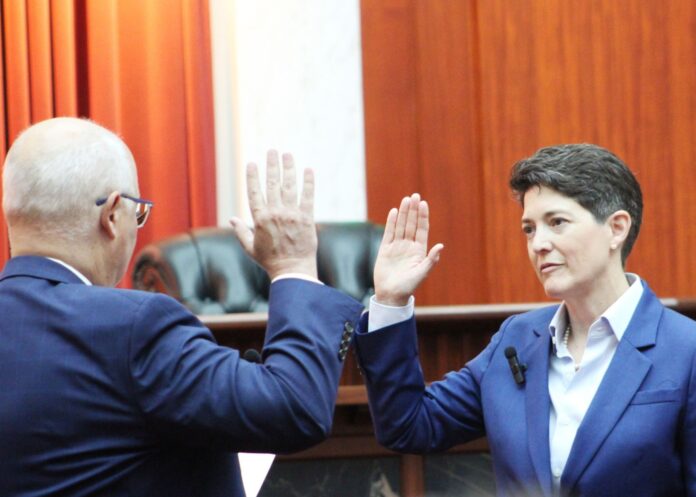
Colorado Supreme Court Chief Justice Monica Márquez became the first Latina to take on the role when she was sworn in at the end of July.
She’s one of 11 state supreme court justices in the country who openly identify as LGBTQ, and having grown up in Grand Junction, she is only the second chief justice from the Western Slope in state history.
While her job as a justice is to be fair and impartial, Márquez said she appreciates what it means for people to see someone who understands their life experience in a position of power like hers. Colorado Gov. Bill Ritter, a Democrat, appointed Márquez to the Colorado Supreme Court in November 2010.
“I have come to believe that it increases the public’s confidence in our judicial branch when members of the bench who are serving the community actually reflect the communities that they serve,” Márquez said in an interview with Newsline this week. “I think it breeds confidence in the decisions that are issued, I think it breeds confidence in the fairness of the process.
“On our court, all seven of us bring our respective batch of life experience, and I think what helps contribute to wiser decisions is when that group of seven brings a wealth and breadth of life experience to the table — mine is just one of those,” Márquez said.
The chief justice serves as the state judicial branch’s top executive, overseeing the soon-to-be 23 judicial districts in addition to the regular duties of justice on the Colorado Supreme Court. The court voted unanimously in 2020 to institute three-year rotating terms for the chief justice role. Márquez said in the short time since she started, being chief justice “feels like two and a half full time jobs right now.”
“Most of the leadership that I have to exert is leadership of influence, trying to organize people and get us all paddling in the same direction,” Márquez said.
Márquez succeeds outgoing Chief Justice Brian Boatright, who led the state judicial department through a tumultuous three years recovering from allegations of misconduct and workplace culture issues. The Colorado Legislature overhauled judicial disciplinary procedures last year after investigations produced scathing reports on the judicial branch’s toxic workplace culture. Former Chief Justice Nathan Coats, Boatright’s predecessor, was censured for his role leading the branch during the time allegations arose.
The big takeaways for us were the need for better compensation, the need for better training, the need for better attention to employee well-being.
– Colorado Supreme Court Chief Justice Monica Márquez
Boatright tasked Márquez with leading the branch’s efforts to improve workplace culture, which she said started with listening tours each of the seven justices conducted with judicial employees across the state. Since she’s taken on the chief justice role, she passed leadership of workplace culture initiative to Justice Melissa Hart.
“The big takeaways for us were the need for better compensation, the need for better training, the need for better attention to employee well-being, and so we’ve used that to sort of guide our priorities,” Márquez said. “This isn’t a top down, we’re gonna tell you what needs to happen, kind of effort, but rather, we’re inviting you to the table to tell us your ideas, and how can we support you as we try to implement those.”
Márquez said the branch is in “a period of significant transition” as the branch has seen high turnover at all levels, including judicial clerks, probation staff and judicial officers. It’s an opportunity, she said, to rebuild a “stronger and better culture, and one that I hope is a little bit more unified in its approach.”
The branch also adopted new mission and vision statements, which Márquez said she hopes will be embedded in every aspect of the judicial department’s work.
“If I’ve learned anything over the last four years, it’s that we often cannot predict what’s right around the corner,” Márquez said. “It’s all fine and good for me to have broadly stated goals and plans, and then there’s reality, and a lot of what we end up having to do is just react and respond to the challenges that we confront.”
The branch started to roll out a new job classification and compensation model in July, which Márquez said employees have seen as “a big win.” She said there will be more refinements to come, but the basic infrastructure is in place so employees can see where they can progress within their job classifications — something they didn’t have before.
The judicial department also launched a new training committee so that state training more consistently aligns with employee needs. Márquez said the branch started two other committees, one for judicial officers and one for employees, to prioritize well-being. The employee committee is working to develop a toolkit judicial districts can use to find opportunities for flexible work.
“Some jobs in the branch are amenable to work from home or virtual work. Other jobs are very much not because they’re customer-facing, and so how do we get creative in creating flexibility with schedules, lunch breaks, whatever it looks like,” Márquez said.
Márquez said she has seen “tons of enthusiasm” for the changes that started as employee-driven efforts, with everyone working toward the same shared values: integrity, fairness and transparency.
“Those values can play out slightly differently in different communities — sort of what the culture looks like on the Western Slope, then in Fort Collins, then in Alamosa — so there’s room for some flexibility in how those have those are implemented,” Márquez said. “But they’re at least a way to articulate the key things that bind us as a judicial branch community.”
This story first appeared at Colorado Newsline. Colorado Newsline is part of States Newsroom, a national nonprofit news organization. Colorado Newsline is a nonprofit, nonpartisan, independent source of online news.

